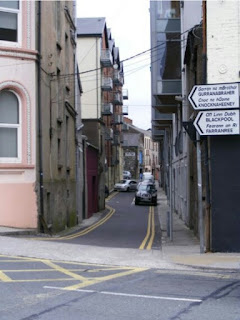In the autumn of 1920 senior members of the Cork IRA met at the premises of the Wallace sisters on St Augustine Street. The meeting was called to hatch a plan to get Lord Mayor Terence MacSwiney out of Brixton Prison. He was on hunger strike and growing weaker by the day so a plan was agreed - kidnap the highest ranking British military officer in Cork to exchange for MacSwiney.
General Strickland
Major General Sir Edward Peter Strickland was the target of the IRA kidnap party. He resided at Sidney House, just off Patrick's hill, which was home to the governor of the military in Cork. The imposing building was better known as Government House. It was from here that his movements were closely watched by members of the IRA and it was decided to kidnap him on one of his many journeys from Government House down to the quayside where he would take a steamer to England.
Government House which was burnt down by Anti-Treaty IRA in 1922. It could be seen from Patrick Street before its destruction. Today it is the site of Christian Brothers School.
The Active Service Unit of the Cork No. 1 Brigade was tasked with the mission with Sean O'Hegarty heading the operation. Dan "Sandow" Donovan , who got his nickname for his likeness to a German showman called Eugene Sandow, was a member of the kidnap party. Dr Patrick O'Sullivan who was then a medical student was also part of the plan. Michael Murphy a carpenter who was also a famed hurler with the Rockies and Cork was O'Hegartys right hand man. Michael Kenny worked as a polisher in Victoria Barracks (now Collins Barracks) and he was tasked with identifying Strickland so he was positioned near Wellington Place and Patrick's Hill to raise the alarm when Strickland approached. The Grey brothers, Miah and James, who ran a motor garage near the gates of Victoria Barracks were tasked with jumping on the running boards of Strickland's car and pull him out. Two cars were positioned on Bridge Street to take the kidnapped British General to a safe house in Ballincollig. The plan was to grab him as the car turned the corner from Patrick's hill onto MacCurtain street but, the plan did not play out like that!

Peadar Kearney & Sean O'Hegarty at Ballingeary Aeriocht.
Strickland made a regular trip to England which would see him journey from Government House in a touring car from Sidney hill, along Wellington Place down Patrick's Hill onto MacCurtain Street and onwards to Penrose Quay to board a steamer.
Dan "Sandow" Donovan in his later years.
Grave of Sandow at St Finbarrs Cemetery.
The kidnap party positioned themselves on September 9th and remained there until Strickland was sighted in his car on the 24th. The long wait saw tardiness creep into the plan, some of the volunteers would buy the Evening Echo and others would chat to passers by to while away the hours.
Witness statement of Dr Patrick O'Sullivan, 8th Battalion Cork No. 1 Brigade.
At 5:45pm Kenny, who was positioned at the corner of Patrick's hill and Wellington Place, saw Strickland's car approaching. The British general was dressed in civilian clothes and along with his driver there were three other military men in the vehicle.
The corner of Patrick's hill and Wellington Place where Vol. Michael Kenny was positioned.
Kenny alerted the others at the bottom of the hill but they failed to notice. In utter desperation Kenny drew his revolver and shot at the car. The gunfire finally alerted the rest of the Volunteers and Kenny then chased the car down the hill while continuing to shoot. When it reached the corner of Patrick's hill and MacCurtain Street all hell broke loose.
Bridge Street then and now - looking towards Patrick's hill with the junction at MacCurtain street on the right.
As Strickland's car turned the corner onto MacCurtain street a bullet hit the British General's shoulder. Those in the car returned fire and bullets smashed the windows of the public house on the corner (now Gallaghers) while bullets bounced off the walls of Ryan's furniture shop and the Cuban House Cigar Divan (now Subway).
The scene of the chaos - MacCurtain Street once known as KingStreet.
The driver of Stricklands car was also hit by a bullet and smashed into a tramline pole but sonehow he manged to keep the car going before speeding down towards Penrose Quay and away from the IRA kidnap party.
Witness statement of Commandant Michael Murphy, 2nd Battalion Cork No.1 Brigade.
Strickland and his driver escaped with their lives and the Cork IRA rued the botched kidnap attempt. Lord Mayor MacSwiney died a month later in Brixton Prison after 74 days hunger strike.
General Strickland continued to command the British army in Cork, overseeing the destruction of the city in December 1920 when crown forces set fire to it. He also caused consternation among Cork protestants when he launched a recruitment of informers from the protestant population in the city. Some accepted Strickland's offer to become informer but others rebuked his pressure to inform on neighbours and work colleagues.
After the War of Independence Strickland served in Egypt before retiring in 1931. He died in his stately home in Norfolk in 1951, thirty one years after his close call on Patrick's Hill.


























































